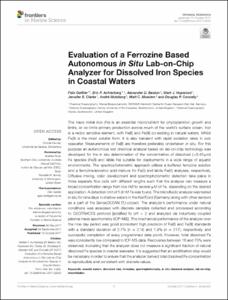| dc.contributor.author | Geissler, Felix | |
| dc.contributor.author | Achterberg, Eric P. | |
| dc.contributor.author | Beaton, Alexander D. | |
| dc.contributor.author | Hopwood, Mark J. | |
| dc.contributor.author | Clarke, Jennifer S. | |
| dc.contributor.author | Mutzberg, André | |
| dc.contributor.author | Mowlem, Matt C. | |
| dc.contributor.author | Connelly, Douglas P. | |
| dc.date.accessioned | 2021-06-24T11:25:03Z | |
| dc.date.available | 2021-06-24T11:25:03Z | |
| dc.date.issued | 2017 | |
| dc.identifier.citation | Geissler, F., Achterberg, E.P., Beaton, A.D.,
Hopwood, M.J., Clarke, J.S., Mutzberg, A.,
Mowlem, M.C. and Connelly, D.P. (2017)
Evaluation of a Ferrozine Based
Autonomous in Situ Lab-on-Chip
Analyzer for Dissolved Iron Species in
Coastal Waters.
Frontiers in Marine Science, 4:322, 13pp.
DOI: 10.3389/fmars.2017.00322 | en_US |
| dc.identifier.uri | https://repository.oceanbestpractices.org/handle/11329/1593 | |
| dc.identifier.uri | http://dx.doi.org/10.25607/OBP-1092 | |
| dc.description.abstract | The trace metal iron (Fe) is an essential micronutrient for phytoplankton growth and
limits, or co-limits primary production across much of the world’s surface ocean. Iron
is a redox sensitive element, with Fe(II) and Fe(III) co-existing in natural waters. Whilst
Fe(II) is the most soluble form, it is also transient with rapid oxidation rates in oxic
seawater. Measurements of Fe(II) are therefore preferably undertaken in situ. For this
purpose an autonomous wet chemical analyzer based on lab-on-chip technology was
developed for the in situ determination of the concentration of dissolved (<0.45μm)
Fe species (Fe(II) and labile Fe) suitable for deployments in a wide range of aquatic
environments. The spectrophotometric approach utilizes a buffered ferrozine solution
and a ferrozine/ascorbic acid mixture for Fe(II) and labile Fe(III) analyses, respectively.
Diffusive mixing, color development and spectrophotometric detection take place in
three separate flow cells with different lengths such that the analyzer can measure a
broad concentration range from low nM to several μM of Fe, depending on the desired
application. A detection limit of 1.9 nMFe was found. Themicrofluidic analyzer was tested
in situ for nine days in shallow waters in the Kiel Fjord (Germany) along with other sensors
as a part of the SenseOCEAN EU-project. The analyzer’s performance under natural
conditions was assessed with discrete samples collected and processed according
to GEOTRACES protocol [acidified to pH < 2 and analyzed via inductively coupled
plasma mass spectrometry (ICP-MS)]. The mechanical performance of the analyzer over
the nine day period was good (consistent high precision of Fe(II) and Fe(III) standards
with a standard deviation of 2.7% (n = 214) and 1.9% (n = 217), respectively, and
successful completion of every programmed data point). However, total dissolved Fe
was consistently low compared to ICP-MS data. Recoveries between 16 and 75% were
observed, indicating that the analyzer does not measure a significant fraction of natural
dissolved Fe species in coastal seawater. It is suggested that an acidification step would
be necessary in order to ensure that the analyzer derived total dissolved Fe concentration
is reproducible and consistent with discrete values. | en_US |
| dc.language.iso | en | en_US |
| dc.rights | Attribution 4.0 | * |
| dc.rights.uri | http://creativecommons.org/licenses/by/4.0/ | * |
| dc.subject.other | Dissolved iron | |
| dc.subject.other | Ferrozine | |
| dc.subject.other | Spectrophotometry | |
| dc.subject.other | Lab-on-chip | |
| dc.subject.other | Microfluidics | |
| dc.title | Evaluation of a Ferrozine Based Autonomous in Situ Lab-on-Chip Analyzer for Dissolved Iron Species in Coastal Waters. | en_US |
| dc.type | Journal Contribution | en_US |
| dc.description.refereed | Refereed | en_US |
| dc.format.pagerange | 13pp. | en_US |
| dc.identifier.doi | 10.3389/fmars.2017.00322 | |
| dc.subject.parameterDiscipline | Other inorganic chemical measurements | en_US |
| dc.bibliographicCitation.title | Frontiers in Marine Science | en_US |
| dc.bibliographicCitation.volume | 4 | en_US |
| dc.bibliographicCitation.issue | Article 00322 | en_US |
| dc.description.sdg | 14.a | en_US |
| dc.description.eov | N/A | en_US |
| dc.description.adoption | Validated (tested by third parties) | en_US |
| dc.description.sensors | In situ chemical analyzer | en_US |
| dc.description.methodologyType | Method | en_US |
| dc.description.methodologyType | Reports with methodological relevance | en_US |
| obps.contact.contactname | Felix Geißler | |
| obps.contact.contactemail | fgeissler@geomar.de | |
| obps.resourceurl.publisher | https://www.frontiersin.org/articles/10.3389/fmars.2017.00322/ | |
 Repository of community practices in Ocean Research, Applications and Data/Information Management
Repository of community practices in Ocean Research, Applications and Data/Information Management

